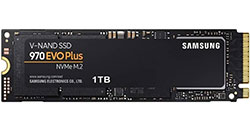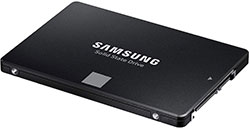With the Crucial P1, the manufacturer launched the P-Series, which was to include NVMe drives in the M.2 format, at the end of 2018. With the Crucial P5, another offshoot appeared in mid-2020, which almost fully exploits the potential of the PCI Express interface and can compete with the fastest SSDs. But how do the Crucial P5 and the Crucial P1 differ in comparison? What are the respective advantages of the two SSDs from Crucial?
- ADS -
Advantages Crucial P5 compared to Crucial P1
- Higher reading and writing performance
- Faster 3 Bit TLC memory instead of 4 Bit QLC
- Better TBW and MTTF values
- Also available with 250 GB
Advantages Crucial P1 compared to Crucial P5
- Sufficient power for normal users
- Significantly lower costs per gigabyte
- Tendency to lower prices
find best buy SSD on Amazon.com #ad
shop worldwide on | Amazon.com #ad | computeruniverse.net | eBay.com | AliExpress.com |
Comparison of storage type and format
The biggest difference between the Crucial P1 and the Crucial P5 can be found deep inside the two drives, in the type of flash memory used. While Crucial still uses the 4 Bit QLC for the P1 series, which is cheaper but also a bit slower due to the higher memory density, the P5 series uses the widespread and tendentially faster 3 Bit TLC. Otherwise the two drives are in comparison NVMe SSD hard disks in M.2 2280 form factor.

Differences in performance and speed
Both the Crucial P5 and the Crucial P1 use the PCI Express 3.0 interface in the configuration with the 4 data lines to exceed the limiting performance limits of the SATA interface. But despite the same connection, the differences in performance between the NVMe SSDs from Crucial are significant in comparison. The Crucial P5 reaches a maximum of 3,400 MB/s read and up to 3,000 MB/s write. The Crucial P1 achieves 2,000 MB/s and 1,750 MB/s respectively. However, the speeds are sometimes reduced considerably at lower capacities.
Parallels in storage capacity and warranty
The Crucial P1 and Crucial P5 overlap in the memory sizes offered. The former is available with 500 GB, 1 TB and 2 TB. The P5 series is additionally available in the beginner-friendly version with 250 GB. On the two M.2 SSD drives in comparison Crucial grants a warranty of 5 years. However, it should be noted that the allowed amount of data with which the Crucial P5 can be written without warranty restrictions is three times higher than that of the Crucial P1. Also the value for the theoretical lifetime of the memory cells is higher for the newer SSD series.

Conclusion SSD comparison – Crucial P5 and Crucial P1 differences
The Crucial P5 almost reaches the performance limits of the PCIe interface, which is also its biggest advantage compared to the Crucial P1. The first SSD from the manufacturer’s P series, on the other hand, impresses with its lower costs per gigabyte and the resulting lower prices. If you are looking for a fast NVMe drive with a very good price-performance ratio, you should go for the Crucial P5. If you want to buy a cheap NVMe SSD drive, the Crucial P1 is worth a closer look, although the speed differences to the P5 series will be less noticeable in practice.
find best buy SSD on Amazon.com #ad
shop worldwide on | Amazon.com #ad | computeruniverse.net | eBay.com | AliExpress.com |
Crucial P5 vs Crucial P1 – Technical data comparison differences
| product | Crucial P1 | Crucial P5 |
| form factor | M.2 2280 SSD | M.2 2280 SSD |
| interface | PCIe Gen 3.0 x4, NVMe | PCIe Gen 3.0 x4, NVMe |
| capacity | 500 GB 1 TB (1.000 GB) 2 TB (2.000 GB) |
250 GB 500 GB 1 TB 2 TB |
| dimensions | M.2 2280 standard | M.2 2280 standard |
| NAND type | 4 Bit QLC | 3 Bit TLC |
| sequential read | 1.900 MB/s (500 GB) 2.000 MB/s (1 TB, 2 TB) |
3.400 MB/s |
| sequential write | 950 MB/s (500 GB) 1.700 MB/s (1 TB) 1.750 MB/s (2 TB) |
1.400 MB/s (250 GB) 3.000 MB/s (500 GB, 1 TB, 2 TB) |
| reliability (MTTF) | 1,5 million hours | 1,8 million hours |
| TBW | 100 TB (500 GB) 200 TB (1 TB, 2 TB) |
150 TB (250 GB) 300 TB (500 GB) 600 TB (1 TB) 1.200 TB (2 TB) |
| warranty | 5 years limited | 5 years limited |

